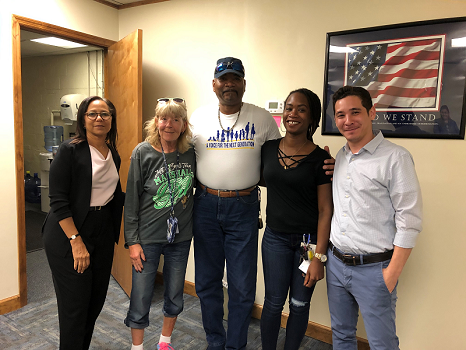News & Updates — President’s Update
President’s Update, Oct. ’19: Once the Epicenter of the Opioid Crisis, Huntington, WV, Is Focusing on Solutions
October 30, 2019Earlier this month, my staff and I visited Huntington, W.V., a city that made headlines in 2016 after 26 residents overdosed in a four-hour period. Leaders of this small Appalachian city bordering Kentucky and Ohio have strived to understand the problem by working with researchers to identify the rates and types of injection drug use, the demographics of those affected, and the problems they face. Now the city is emerging as a leader in finding and implementing solutions. During our visit, we saw how city leaders and their community partners have rallied around residents suffering from opioid use disorder by promoting harm reduction and increasing access to treatment.

For example, in December 2017, the city established a Quick Response Team (QRT) through their Cabell County Emergency Medical Services. The QRT includes a paramedic, a peer recovery coach, a clergy member, and a police officer. Team members reach out within 72 hours and often sooner to residents whose opioid overdoses were reversed when paramedics administered naloxone. They encourage people to seek treatment or promote harm-reduction strategies for those who are not yet ready to do so—visiting multiple times in efforts to persuade people they care about their recovery. The approach is modeled on a program in Colerain Township, a suburb of Cincinnati, Ohio, and was launched with $1.35 million in federal grants. Team members’ persistence and resourcefulness have been remarkable. Not only will they search for available beds in treatment facilities and help people enroll in Medicaid coverage, they’ve even driven some to other states for care. Their knowledge of and presence in the local community contributes to their success: they’ve reached about half of those identified through the emergency medical response system or referrals from concerned family and friends and connected roughly a third of those with treatment.
We also visited PROACT (Provider Response Organization for Addiction Care and Treatment), a nonprofit organization offering medication-based treatment, therapy, education, job training, and other support services within the Valley Health federally qualified health center. It also includes a pharmacy and play space for children whose parents are receiving services and offers group and spiritual counseling. PROACT was developed by local health care providers who came together to fill gaps in local services and collectively finance them.
Community leaders are also thinking about the supports people need during the vulnerable period following initial treatment. Last year, Huntington City Mission, Marshall University Joan C. Edwards School of Medicine, and Marshall Health launched Project Hope for Women and Children, a transitional living facility for new and expectant mothers that provides peer and residential support, life skills training, and mental health services. It can house women and their children for up to six months, allowing them to continue in treatment and receive counseling and job training services.
Finally, we had the opportunity to meet with local foundations, including our host organization, The Pallottine Foundation, that have supported these and other efforts and are now working to spread lessons across West Virginia and beyond. They are also focusing on what Huntington needs to sustain current initiatives and build a healthier community for the future. One strategy for doing so is placing social workers in elementary schools, where they offer support to children living with parents or other adults struggling with addiction.
The visit to Huntington serves as an important reminder of why we do this work and suggests that a having a vision for a better future, collaboration, commitment, and compassion are key ingredients in efforts to curtail the opioid crisis. We also witnessed the value of projects that are embedded in the community and reflect local values, culture, and leadership. The city has seen a 25 percent decline in overdose death rates since this work got underway.
(Picture: The Quick Response Team—which includes Larrecsa Cox, a paramedic with Cabell County Emergency Medical Services; Virgil Johnson, a faith leader; and Sue Howland, a peer recovery coach with Prestera Center—has been known to make as many as eight attempts to reach someone.)